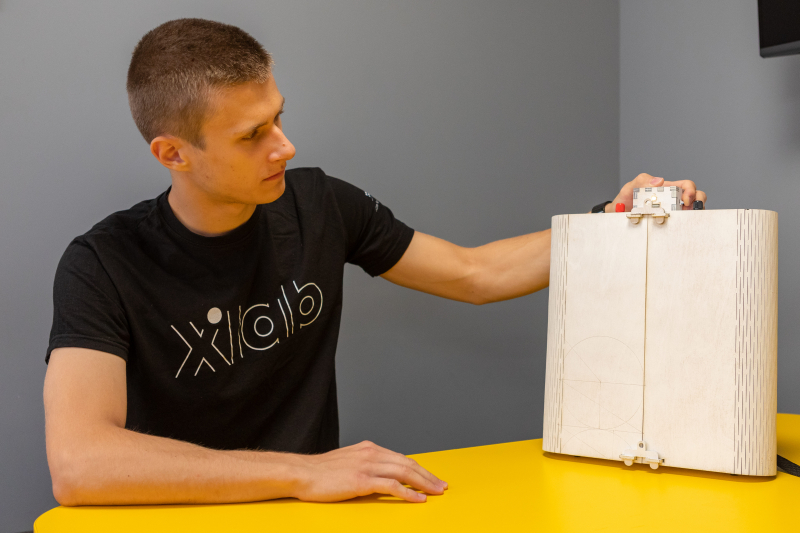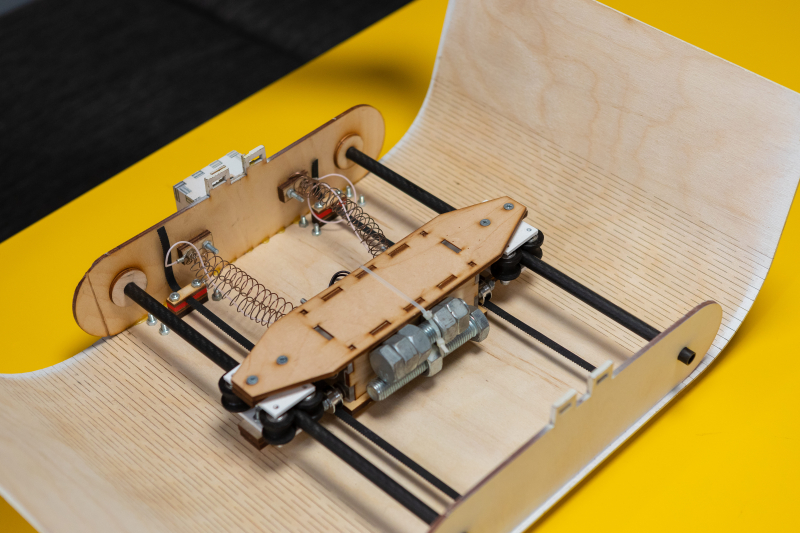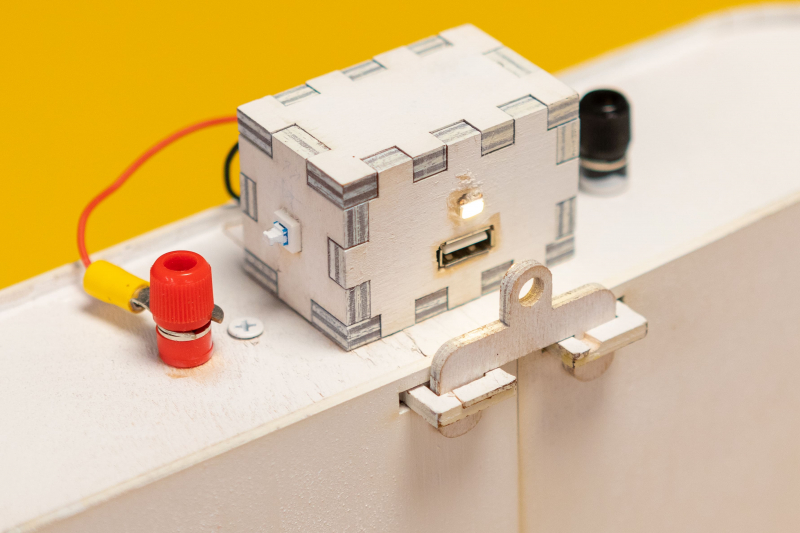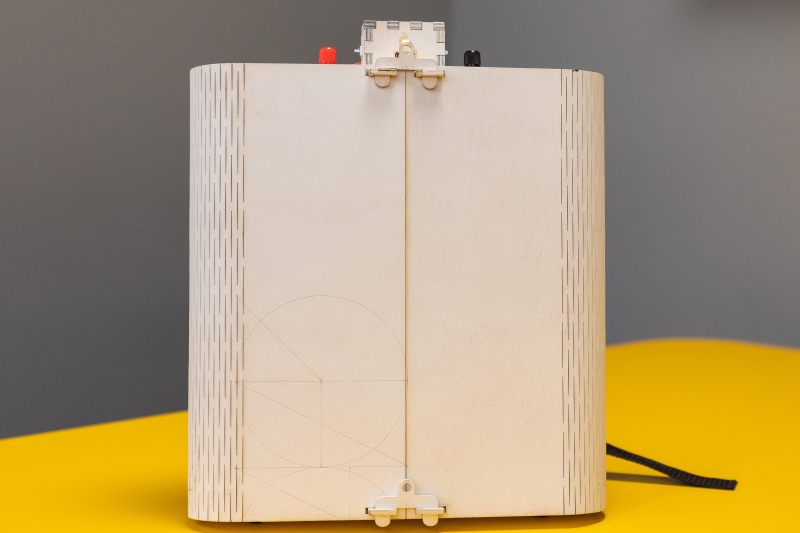Originally, you had planned to make a portable charger to be worn on the leg. It would also be charged by walking. Why did you decide to switch to a backpack?
I came up with the idea of a charger powered by body movements in 2019 during ITMO’s Simple Innovations contest. Initially, I did want to make a charger that would be worn on a person’s leg. I assembled a prototype, but unfortunately it came out too bulky and inefficient. Moreover, it could’ve been unhealthy if worn on a regular basis because such constant weight on one leg could disturb the user’s walking pattern.
A year later, my lecturer suggested I bring my idea to a summer school at the Sirius educational center. It’s something like a summer camp for school students from all over Russia where they develop their chosen projects in teams over a month. I went there as a mentor and lecturer for the students.

Maksim Myagkih and other participants of the Big Challenges contest at the Sirius educational center. Credit: vk.com/sirius.talents
My team had five girls and two boys. I held lectures and workshops and continued working on the project. It was then that I understood that a backpack-based device would be much more functional than a wearable one.
Why a backpack? We ran a survey at Sirius (among 500-600 participants) and it turned out that the majority of young people between 15 and 20 regularly carry a backpack. I, for one, feel almost naked if I don’t have one on me. You put it on and go places without giving it a second thought.
What is the backpack like?
It will be an alternative to portable chargers, which you need to recharge constantly and might forget to take with you. Our device doesn't have these issues.
How often do we need a power bank? Perhaps, once every couple of days. Our charger is integrated into a backpack. It has a moving element that fluctuates during walking because it is attached to the top of the backpack with springs. There are also two regular step engines that generate energy by spinning thanks to a special belt system. The backpack also features a USB outlet that you can plug your phone into.
Of course, it’s not like you can walk for an hour and charge your phone to 100% – the law of conservation of energy makes such a device practically impossible. But if you take the backpack with you to university or to the office for a couple of days, it will gather enough charge to help you make an emergency call if you need to. That’s about 5-10% of the battery.

Maksim Myagkih with the smart backpack prototype. Photo by Dmitry Grigoriev, ITMO.NEWS
How many steps do you need to recharge it?
We calculated everything based on the average of 5,000-7,000 steps a day.
Is the backpack only compatible with phones or can it also charge other devices?
The backpack is meant to charge phones and small devices, such as earphones or watches – they have smaller batteries and would charge faster than a phone. However, our charger won’t be enough for laptops, which have more powerful batteries and take a long time to recharge even if you connect them to a car.
How are you planning to develop the project next?
As I’ve said, the backpack features a fluctuating device. We could, for instance, make it larger and add a compartment for useful weight, such as a water bottle. It would assist the fluctuation and thus speed up the charging.
So far, we only have a prototype made of wood veneer, but in the future we could make it with fabric or leather. Perhaps at some point we’ll be able to increase the charging speed, too. But so far I see this project as a lifesaver of sorts – a handy tool when you're nowhere near an outlet and your phone is dead.
Have you considered commercializing the project? Do you think it could be of interest to green businesses?
The device is not very efficient from the environmental point of view. Charging your phone for an hour and running a heater for a minute requires the same amount of energy. Which means that even if everyone in the city wears such smart backpacks, we won’t significantly bring down the energy consumption.
I think this project could be of interest as a marketing tool to major sports companies – for instance, I could approach the local offices of Nike and Adidas.
Are there any similar products on the market?
Yes, we’ve analyzed our competitors. There are devices that use shoes or are attached to limbs – for instance, a lever system that uses the bending of a knee.

Maksim Myagkih. Photo by Dmitry Grigoriev, ITMO.NEWS
As for backpacks, we have found two reasonable counterparts. The first one generates energy from friction, but that technology is completely different from ours and is much more complicated and expensive. We have also found a mention of a similar development by NATO, but info on that one is not available to the general public.
Shoes are not really suitable for the purpose because it’s not very safe to integrate charging elements into the soles – they can become damaged when walking and result in injury. For instance, if the insulation is compromised by regular deformations of the soles and you get caught in the rain.
It’s also important to remember that the soles of our shoes are a vital orthopaedic element that can directly influence our walking pattern and the functioning of our musculoskeletal system, so any poking around the soles would be undesirable. We can say the same about wearable devices that rely on the wearer’s joints. They can cause bodily damage, they are bulky, and they don’t look very appealing. That’s why a backpack is the best choice.
How safe is the smart backpack?
The electronic components are built in such a way as to make the backpack completely safe. We can also easily make it waterproof if needed. We can also consider that the voltage in a regular power outlet is 220 V, while our backpack doesn’t exceed 5 V.
Of course, every one of us will experience voltage differently, but the lowest harmless voltage is 35-40 V. So our backpack is far below this threshold and can be worn by anyone, including children.








